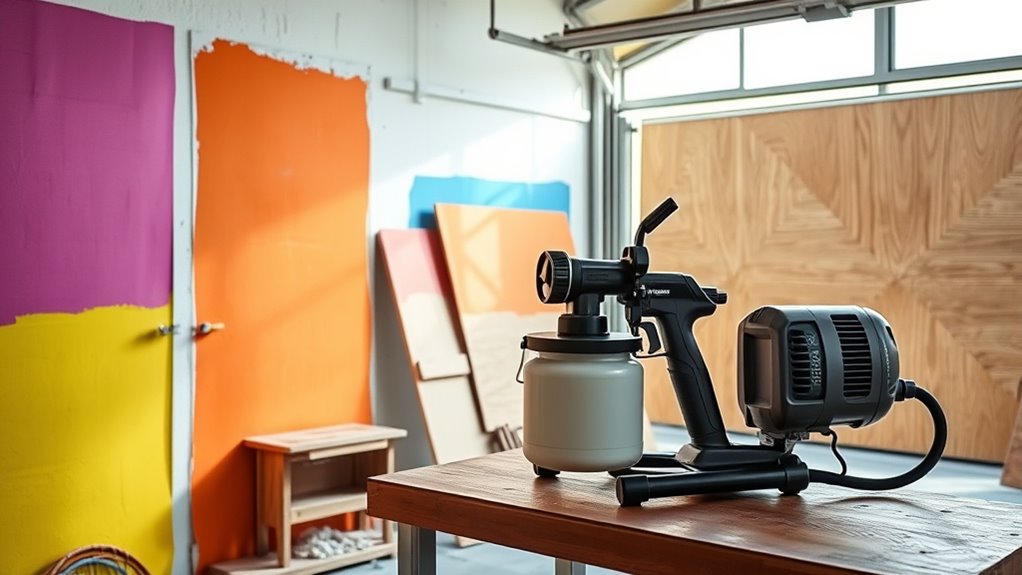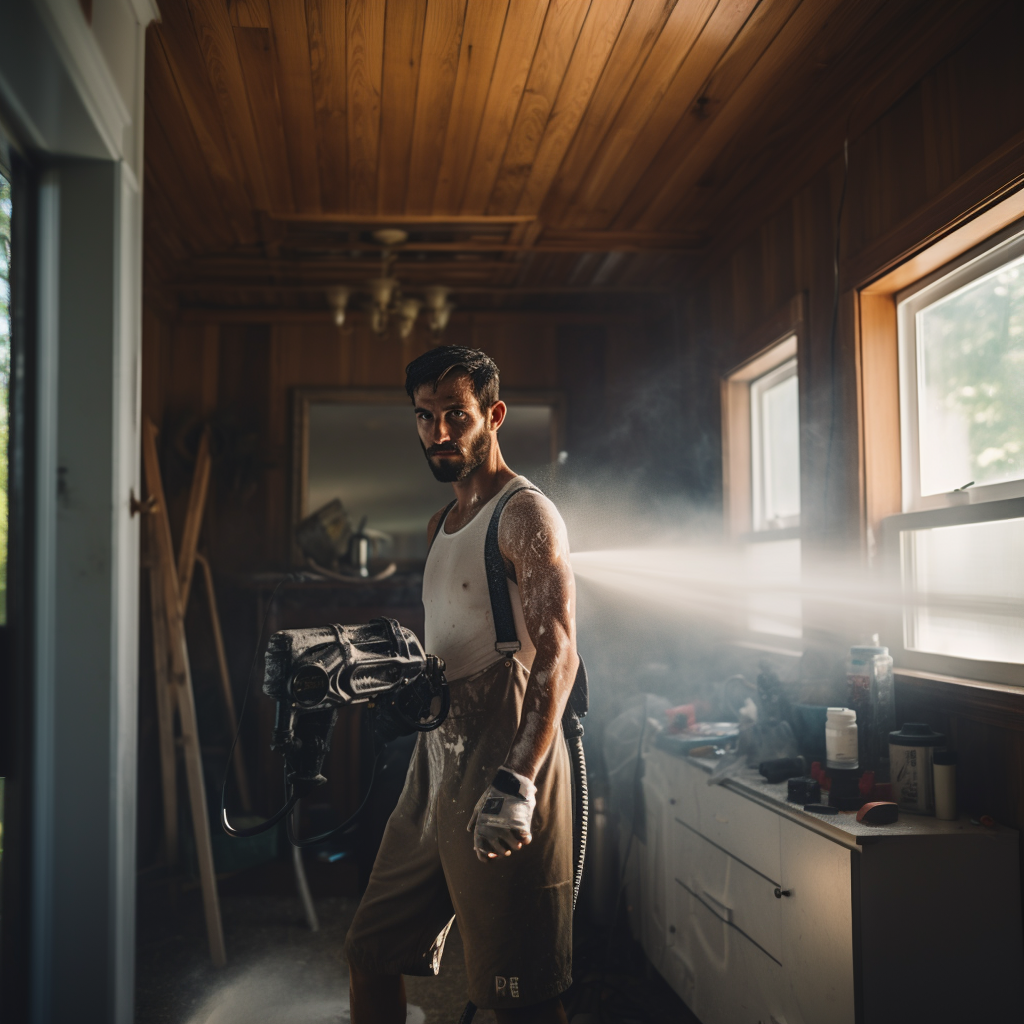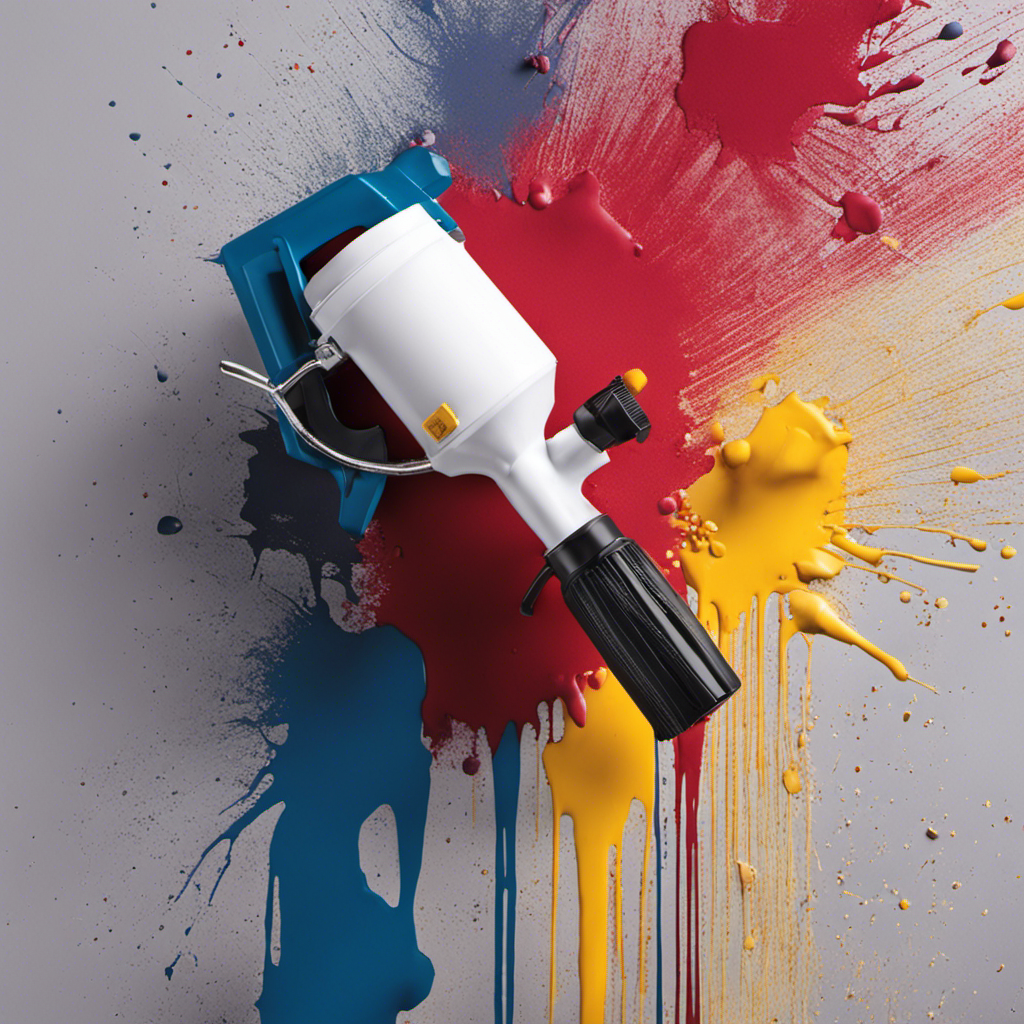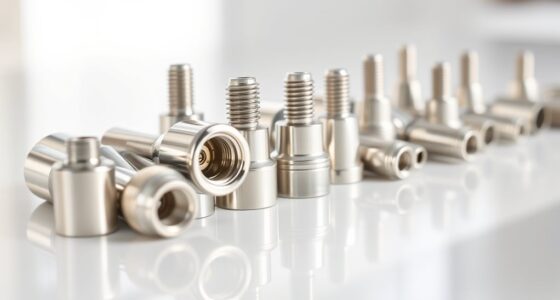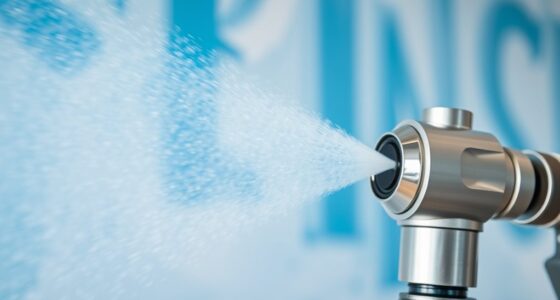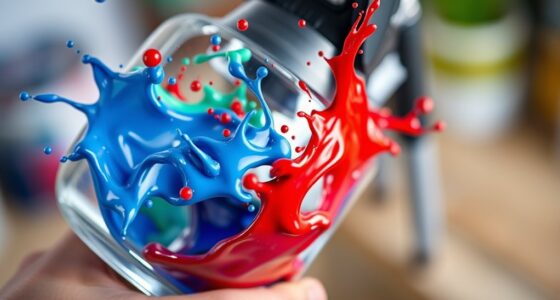Paint sprayers are best for large projects where you want quick, even coverage and a professional finish. They work great on exterior walls, fences, decks, and big surfaces that need smooth results. Sprayers also excel on interior walls, ceilings, furniture, and textured finishes. For thick paints or multiple coats, they help save time and effort. Keep exploring to discover tips that can help you get the most out of your sprayer for any project.
Key Takeaways
- Large exterior surfaces like walls, fences, decks, and outdoor structures for quick, smooth, and even coverage.
- Interior walls, ceilings, and textured finishes for fast, professional-looking decorative applications.
- Projects requiring multiple coats or thick paints, including metal, concrete, or weatherproof coatings.
- Commercial or industrial applications that demand durable, weather-resistant, and uniform finishes.
- Detailed or tricky areas such as edges, corners, or intricate designs where combined spraying and brushing are effective.
Large Exterior Walls and Surfaces
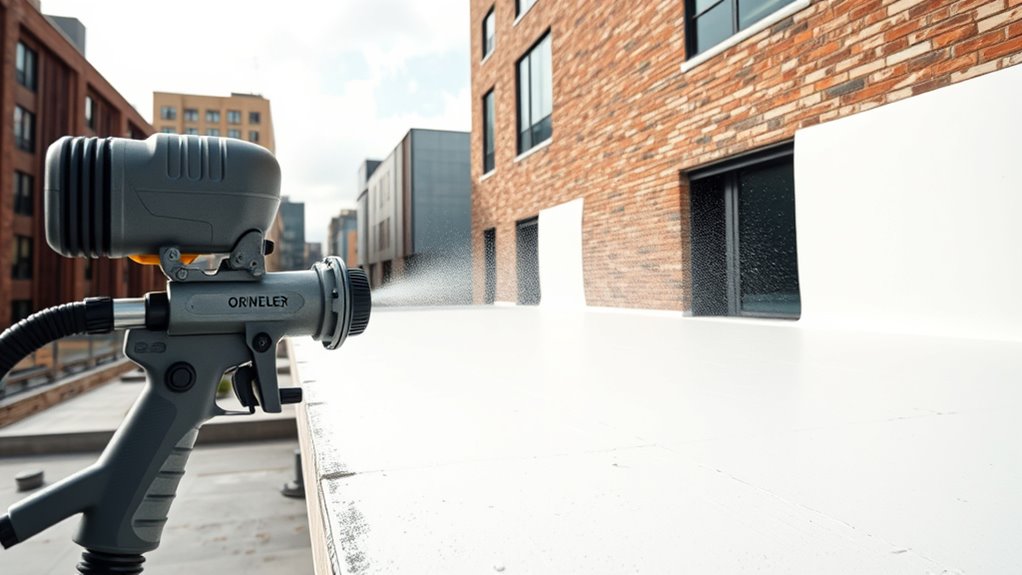
When it comes to painting large exterior walls and surfaces, using a paint sprayer can considerably speed up the project and provide a smooth, even finish. To achieve maximum results, focus on spray pattern adjustment; narrowing or widening the pattern helps control coverage and minimizes drips. Proper nozzle selection is also essential—choose a larger nozzle for thicker paints and bigger surfaces, ensuring even distribution without clogging. Adjusting the spray pattern allows you to cover broad areas efficiently while maintaining precision around edges and corners. Keep in mind that practicing with different settings beforehand helps you find the perfect combination for your specific project. Additionally, selecting the right nozzle type equipment can help optimize the performance of your tools for large-scale painting. Using an appropriate pressure adjustment setting further enhances spray consistency and reduces overspray. With the right spray pattern adjustment and nozzle selection, you’ll complete large exterior tasks faster and with professional-quality results.
Fences and Decks
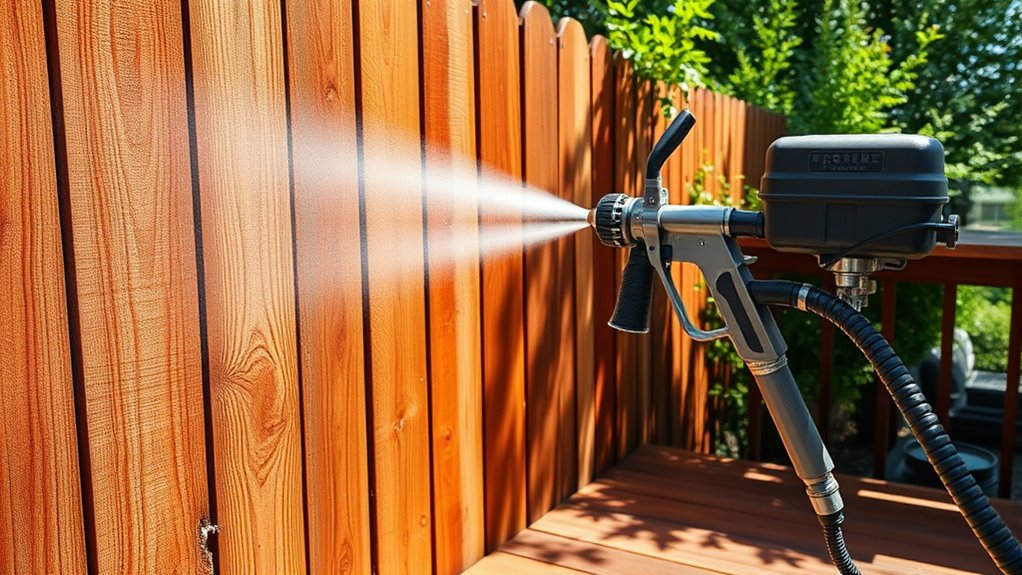
Getting a clean, smooth finish on fences and decks starts with proper surface preparation—scrape off peeling paint and sand rough spots. Use your spray technique carefully to avoid drips and guarantee even coverage. Remember, choosing the right paint that’s compatible with your surface will give you the best, long-lasting results. Incorporating sound vibrations into your application process can also help reduce surface tension and improve paint adhesion, ensuring a more durable finish. Additionally, selecting the appropriate tip size for your sprayer can significantly influence the quality of the finish and coverage. Proper surface preparation not only improves the appearance but also enhances the longevity of your paint job, especially when using high-quality equipment. Paying attention to dog names can also be useful if you are painting or customizing outdoor spaces for pets, making your project more personalized and inviting. Using the correct knitting patterns can also ensure that your painted surface remains intact and evenly coated over time.
Surface Preparation Tips
Preparing your fences and decks before painting is essential for a smooth and long-lasting finish. Start by thoroughly cleaning the surfaces to remove dirt, mold, and old paint. Sand any rough spots and repair damaged areas to ensure an even base. Proper paint mixing is vital—combine your paint well to achieve consistent color and texture. Remember to maintain your brush properly; clean it after each use to keep bristles in top shape, which makes your job easier.
| Feelings You’ll Experience | Results You’ll Achieve |
|---|---|
| Confidence in a perfect finish | Fewer touch-ups needed |
| Satisfaction from a job well done | Beautiful, durable surfaces |
| Pride in your work | Long-lasting paint job |
| Relief knowing it’s done right | Beautiful fences and decks |
Spray Technique Precision
Achieving a flawless finish on fences and decks starts with mastering spray technique precision. To do this, focus on maintaining consistent spray technique, keeping your movements steady and even. Keep the spray gun at a uniform distance from the surface to prevent drips and uneven coverage. Adjust your gun’s settings to ensure proper paint consistency; too thick or too thin can ruin the finish. Use smooth, overlapping strokes to avoid streaks and missed spots. Practice on scrap material if needed, so you can control your spray pattern and speed. Proper spray technique minimizes overspray and maximizes coverage, saving time and effort. Being aware of the Aboriginal approach to traditional art and storytelling can inspire patience and precision in your work. Additionally, understanding support hours for equipment and product availability can help you plan your project timeline effectively. Proper preparation and attention to detail, much like the noise levels considered in modern heat pump design, are key to achieving a professional-looking result on fences and decks. Incorporating knowledge of essential oils and their safe, precise application can also serve as a reminder to take meticulous care with your spray process, ensuring a smooth and even finish. Considering the importance of energy efficiency in appliances can inspire you to select environmentally friendly paints and solvents that improve your project’s sustainability.
Paint Compatibility Matters
Choosing the right paint for fences and decks is essential to guarantee durability and a professional finish. The key is selecting a compatible paint type for your surface material. For wood, use water-based or oil-based paints designed for outdoor use. For vinyl or plastic surfaces, opt for paints specifically formulated for plastics. Metal surfaces require rust-inhibiting paints, while concrete or stone decks need specialized acrylic or elastomeric coatings. Using incompatible paint types can lead to peeling, cracking, or uneven coverage. Proper surface preparation and understanding paint compatibility are crucial for achieving long-lasting results. Additionally, considering the type of surface can help determine which coating will adhere best and withstand environmental stresses. Recognizing the paint application method can also influence the final appearance and durability of your project. When selecting paint, be sure to consider weather resistance, which is vital for outdoor projects exposed to varying climate conditions. Moreover, staying informed about AI-driven innovations in coating technology can help you choose the most advanced and effective products available.
Cabinets and Furniture
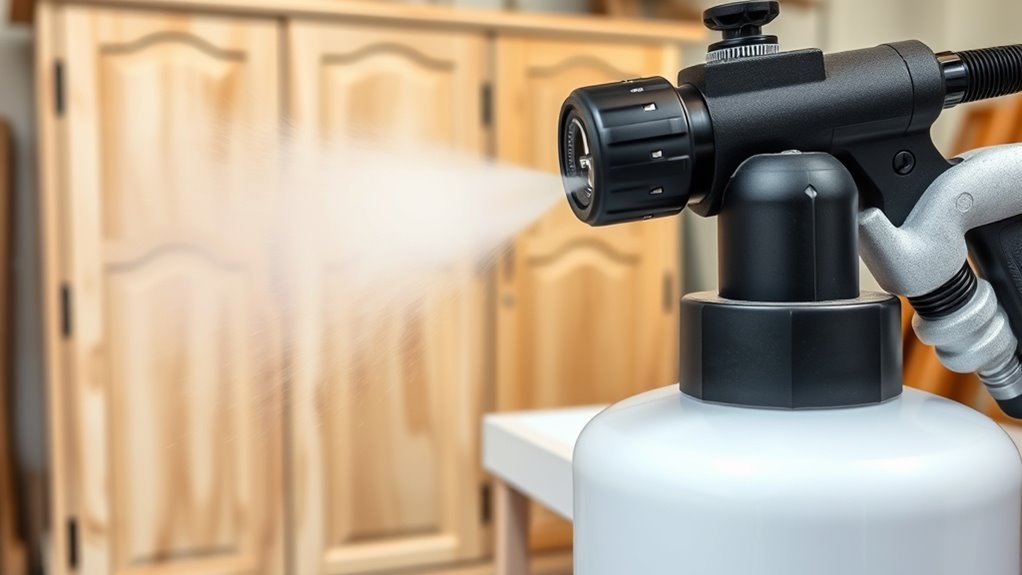
Ever wondered how to give your cabinets and furniture a flawless, professional finish? A paint sprayer is ideal for this task because it provides smooth, even coverage and speeds up the process. You can use it for wood staining, achieving rich, consistent colors that enhance the natural grain. It’s also perfect for creating artistic murals or intricate designs on furniture surfaces, allowing you to add personal touches with precision. The sprayer’s fine mist ensures detailed work and minimizes brush marks. Keep in mind, a sprayer works best on flat or slightly textured surfaces and requires proper preparation, like sanding and priming. Proper technique and understanding paint sprayer projects can help you achieve professional-looking results. Whether you’re updating a single piece or renovating a whole room, a paint sprayer can transform your cabinets and furniture efficiently and professionally. Additionally, understanding Nissan Tuning principles can inspire creative customization and enhancement projects beyond painting.
Interior Wall and Ceiling Painting
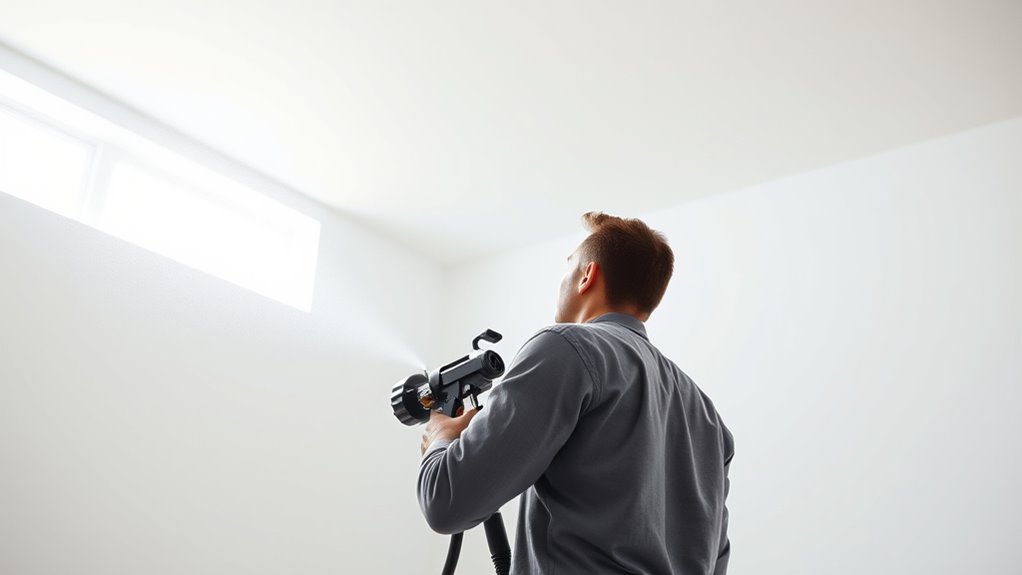
When painting interior walls and ceilings, a paint sprayer offers fast coverage and saves you time. It provides a smooth finish that’s hard to achieve with brushes or rollers, giving your space a professional look. Plus, it’s perfect for covering large areas quickly and efficiently. Incorporating a security system can also help protect your property during renovation projects. Understanding the essential techniques involved in using spray equipment can further enhance your results and prevent common issues like overspray or uneven coating. Additionally, understanding the famous quotes about fatherhood can inspire patience and care during your painting process, ensuring you approach the task with dedication and attention to detail.
Fast Coverage Efficiency
To achieve quick and even coverage on interior walls and ceilings, selecting the right paint sprayer is essential. Paint sprayers cover large areas rapidly, reducing the time spent on brush strokes and minimizing uneven spots. They deliver a consistent spray, ensuring a smooth finish without sacrificing speed. While some models excel at large projects, others offer precision for detailed touch-ups. Here’s a quick comparison:
| Feature | Best for Large Areas | Best for Precision | Ease of Use |
|---|---|---|---|
| Coverage Speed | High | Moderate | Moderate |
| Detail Control | Low | High | High |
| Setup & Cleanup | Quick | Slightly Complex | Easy |
| Suitable Projects | Walls, Ceilings | Trim, Cabinets | Both |
| Finish Quality | Fast, Uniform | Fine, Detailed | Smooth |
This table helps you choose a sprayer that maximizes efficiency without sacrificing quality.
Smooth Finish Quality
Achieving a smooth finish on interior walls and ceilings with a paint sprayer depends on selecting the right equipment and techniques. Start by choosing a sprayer nozzle designed for fine finishes, such as a smaller, precise tip. Adjust the paint viscosity to ensure it flows smoothly without splattering or runs; thinning the paint slightly can help achieve an even coat. Maintain consistent distance and steady motion while spraying to prevent uneven coverage. Overlap each pass slightly to avoid streaks and ensure a uniform appearance. Properly prepared surfaces and controlled spray settings are essential for a flawless finish. With the right nozzle, appropriate paint viscosity, and careful technique, you’ll achieve a professional-looking, smooth interior wall and ceiling surface.
Ideal for Large Areas
Paint sprayers are especially effective for large areas like interior walls and ceilings because they cover surfaces quickly and evenly. This efficiency guarantees you time and ensures a smooth, professional finish. While they excel at broad coverage, they also allow for detail work with airbrush-like precision, perfect for small touch-ups or intricate corners. For large projects, a sprayer reduces fatigue compared to brushes and rollers, making the job less strenuous. Keep in mind that mastering proper technique minimizes overspray and ensures consistent results. Here’s a quick comparison:
| Feature | Benefit |
|---|---|
| Speed | Complete large areas fast |
| Coverage | Even coat without streaks |
| Precision | Airbrush detail for edges |
| Touch-ups | Easy small touch-ups |
| Ease of Use | Simplifies big jobs |
This makes paint sprayers ideal for big projects with detailed finish needs.
Textured and Specialty Finishes
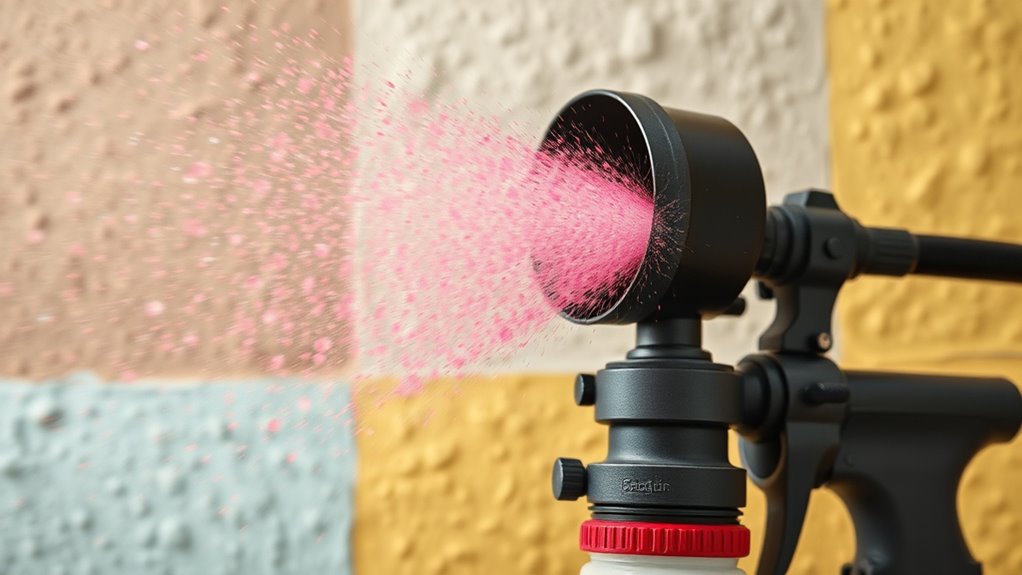
Ever wondered how to add unique character and depth to your walls? Textured and specialty finishes are perfect for creating eye-catching effects. With a paint sprayer, you can easily apply textured finishes, achieving a consistent, professional look that would be difficult with brushes or rollers. Whether you’re aiming for a rough, stucco-like surface or a subtle, decorative pattern, specialty coatings give you endless design options. These finishes are ideal for accent walls or areas where you want to hide imperfections while adding visual interest. A sprayer allows you to work quickly and evenly, making complex textures easier to achieve. If you’re looking to elevate your space with distinctive, durable coatings, a paint sprayer is the perfect tool for textured and specialty finishes.
Metal and Outdoor Structures
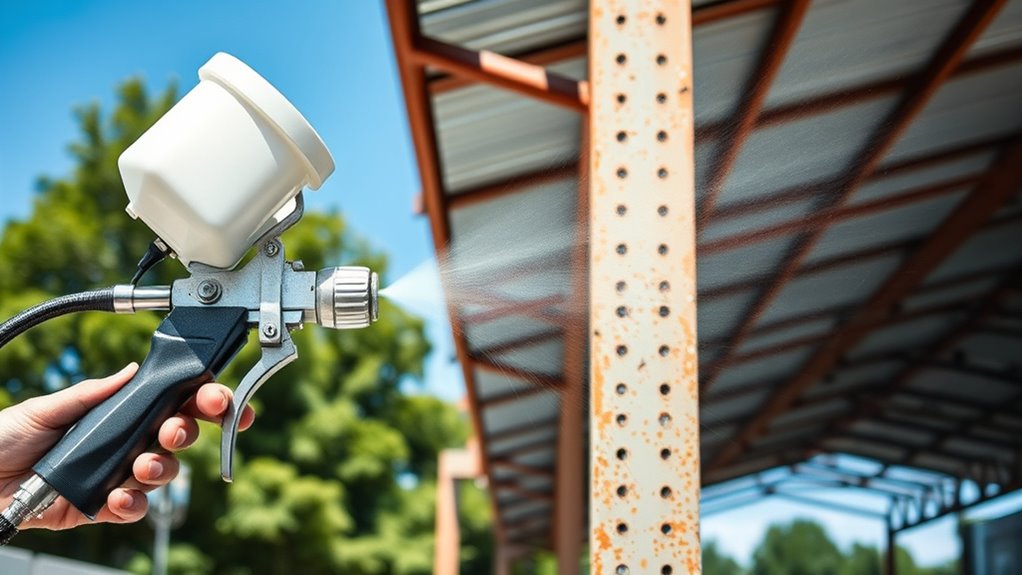
When painting metal and outdoor structures, you’ll want a sprayer that offers strong durability and excellent coverage to withstand the elements. Luckily, many sprayers make application quick and smooth, reducing your effort and time. Choosing the right tool guarantees your project looks great and lasts longer.
Durability and Coverage
Metal and outdoor structures demand a paint sprayer that can withstand harsh weather conditions and resist wear over time. To guarantee durability and full coverage, choose a sprayer designed for tough surfaces, and keep up with regular sprayer maintenance to prevent clogs and ensure consistent results. Proper paint storage is also essential; storing your paint correctly helps maintain its quality and prevents waste. A high-quality sprayer provides even application, reducing the need for multiple coats, which enhances coverage and saves time. Since outdoor projects often face exposure to elements, opt for sprayers that deliver durable, weather-resistant finishes. Investing in the right equipment and maintaining it well guarantees your outdoor structures remain protected and visually appealing for years to come.
Ease of Application
Applying paint to metal and outdoor structures becomes much easier when you choose a sprayer designed for smooth, even coverage. This minimizes uneven brush strokes and guarantees a professional finish. A good sprayer simplifies color mixing, allowing you to blend shades seamlessly without streaks.
To maximize ease of application, consider these points:
- Opt for a sprayer with adjustable settings to control flow and spray pattern.
- Use a model that offers consistent atomization, reducing drips and uneven patches.
- Ensure the sprayer is lightweight and easy to maneuver around complex or large outdoor surfaces.
These features help you achieve flawless results efficiently, making your project smoother and less time-consuming. Proper equipment enhances application, especially on metal and outdoor structures.
Commercial and Industrial Projects
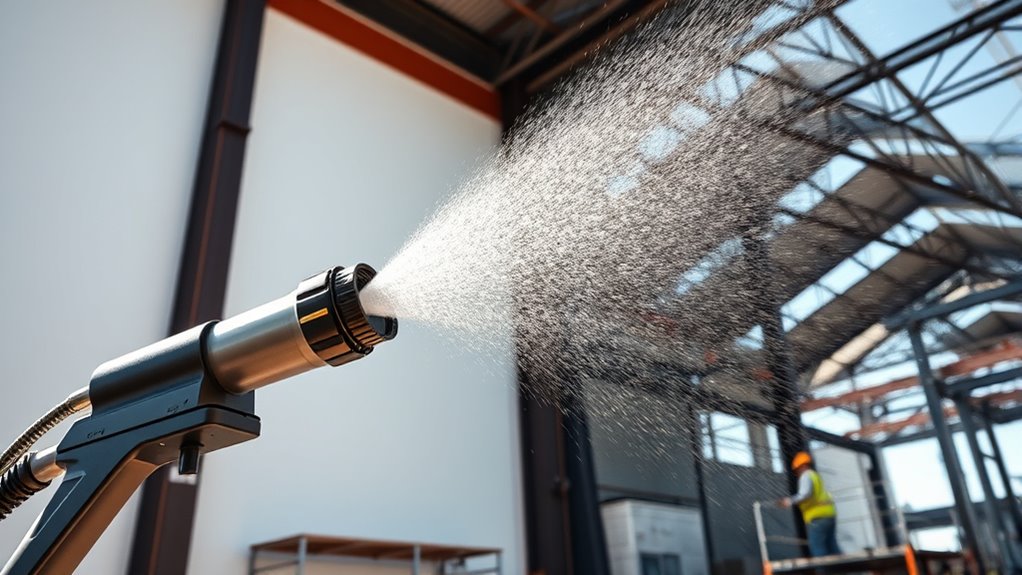
Are you ready to tackle large-scale painting projects in commercial and industrial settings? Paint sprayers are ideal for these applications because they cover extensive areas quickly and provide a smooth, even finish. When working on such projects, proper sprayer maintenance is essential to keep equipment in top shape and prevent costly breakdowns. Regular cleaning and inspection ensure consistent performance. Safety precautions are vital too—always wear protective gear, work in well-ventilated areas, and follow manufacturer instructions to avoid accidents. Using a sprayer for large projects saves time and reduces labor costs, making it a practical choice for warehouses, factories, and large commercial buildings. With the right preparation, a paint sprayer can handle these demanding projects efficiently and safely.
Multiple Coats and Thick Paints
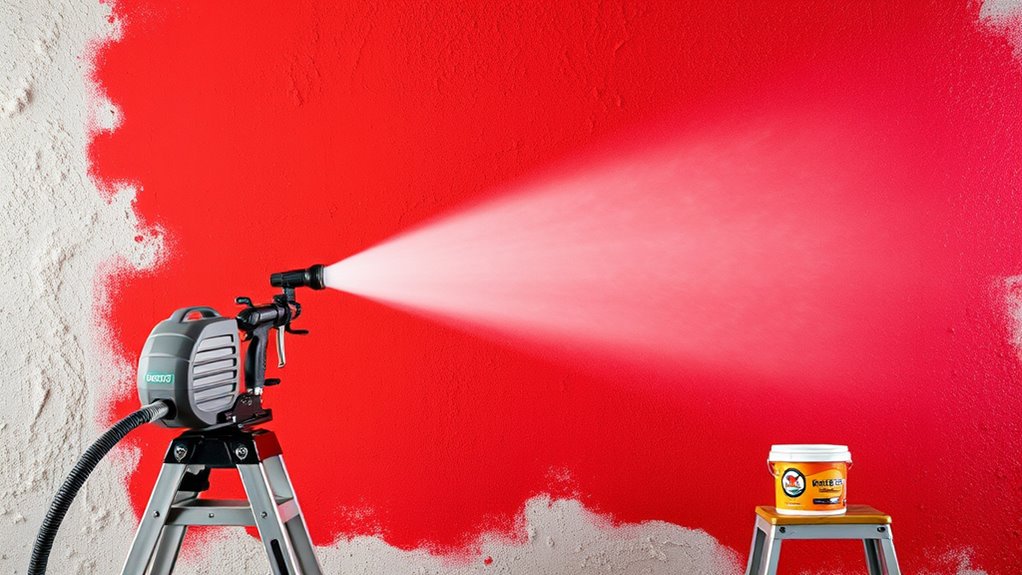
When working with multiple coats and thick paints, choosing the right spray equipment is essential to achieve a smooth, professional finish. You’ll want equipment capable of handling viscosity without clogging or uneven application. To optimize results, consider these tips:
- Use a high-capacity sprayer designed for thick paints, reducing the need for frequent refills.
- Properly mix your paint, thinning it if necessary, to ensure smooth flow and prevent clogging.
- Incorporate brush techniques between coats for edges or tricky spots, and avoid over-brushing to maintain a consistent finish.
Repainting Large Areas Quickly
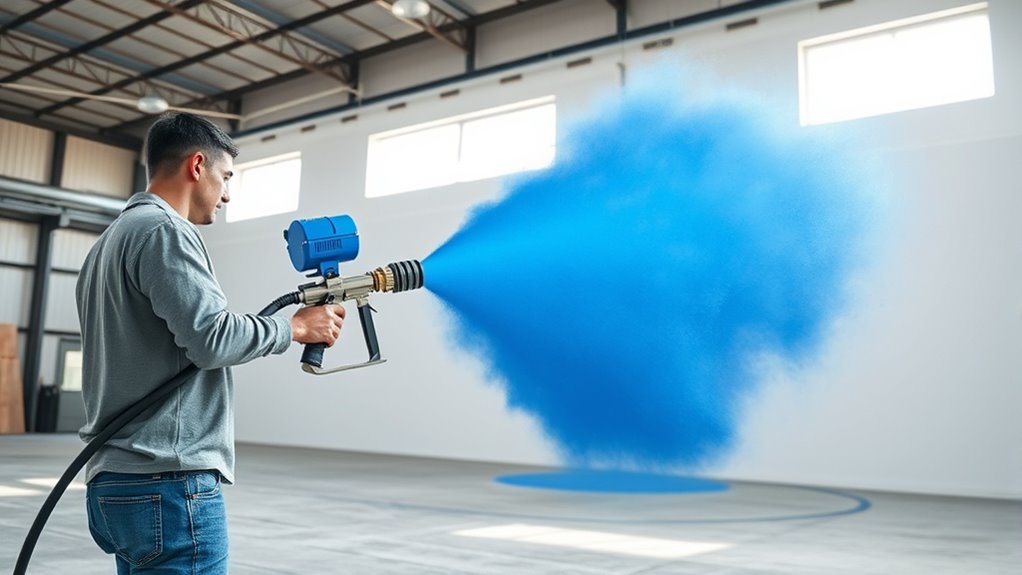
Looking to repaint large areas quickly? A paint sprayer can save you time and effort compared to traditional brushes or rollers. To achieve efficient coverage, make sure your spray gun is properly calibrated for the type of paint you’re using. This guarantees an even application and prevents overspray. Regular brush maintenance is vital; cleaning your spray gun after each use keeps it in top condition and prevents clogs that slow down your work. Adjust the spray pattern and pressure settings to suit large surfaces, allowing for smooth, consistent coverage. With the right setup and maintenance, you’ll finish large projects faster and with less fatigue. Remember, consistent spray gun calibration and diligent brush maintenance are key to maximizing your efficiency when repainting extensive areas.
Projects Requiring a Smooth, Even Finish
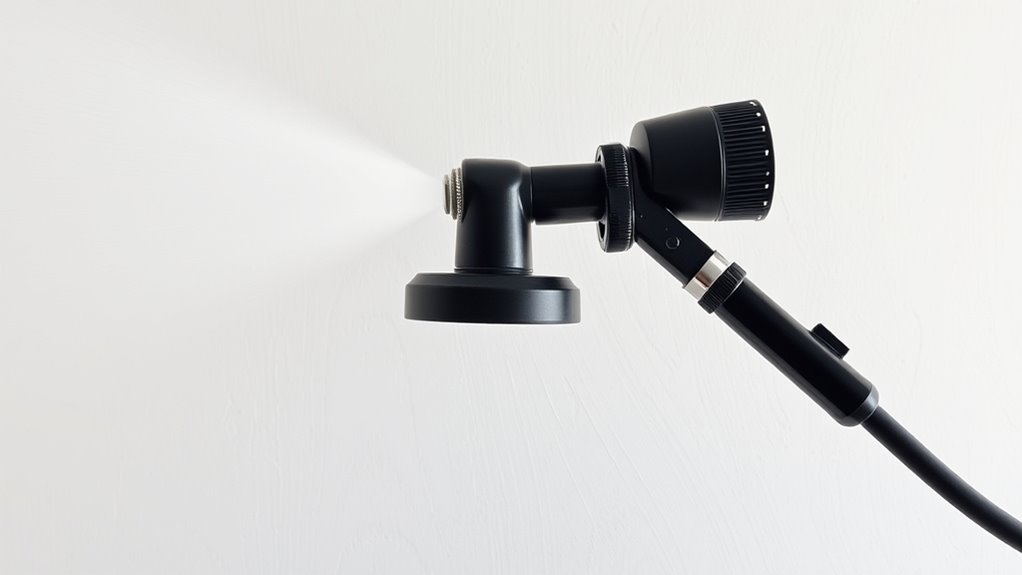
Achieving a smooth, even finish is essential when working on projects where appearance matters most, such as furniture, cabinets, or decorative walls. For these tasks, your choice of sprayer makes a difference.
- Airless sprayers excel at providing a fine, uniform coat that minimizes brush marks and drips, perfect for cabinetry or furniture.
- Air assisted sprayers offer precise control, ideal for decorative walls or intricate woodwork requiring a flawless surface.
- Both sprayer types deliver a consistent finish, but air assisted sprayers typically give you more control over spray pattern and thickness, ensuring an even, professional look.
Using the right sprayer for these projects guarantees a smooth, polished finish that enhances your work’s aesthetic appeal.
Frequently Asked Questions
Can Paint Sprayers Be Used for Detailed or Intricate Designs?
Paint sprayers can be used for detailed or intricate designs, but it depends on the type. Airbrush techniques work well for fine details, giving you control for delicate work. For stencil applications, a sprayer with a fine tip helps you achieve sharp, precise lines. If you want intricate designs, consider an airbrush or a sprayer with adjustable settings to master these techniques and get the results you desire.
Are Paint Sprayers Suitable for Small DIY Craft Projects?
Did you know that 70% of DIY enthusiasts find paint sprayers boost efficiency? For small craft projects, a paint sprayer can be a great choice, especially if you master brush techniques and keep the paint consistency just right. You’ll find it easier to cover surfaces quickly and achieve smooth finishes, but for intricate details, a brush might still be better. Overall, sprayers work well for quick, even coverage on small projects.
What Safety Equipment Is Required When Using a Paint Sprayer?
When using a paint sprayer, you need proper protective gear like a mask, goggles, and gloves to shield yourself from fumes and splatters. Make certain good ventilation to prevent inhaling harmful fumes and to keep the area safe. Always follow ventilation requirements specified in the manufacturer’s instructions, and wear the recommended protective gear consistently. This way, you stay safe while achieving professional results with your paint sprayer.
How Do I Clean and Maintain a Paint Sprayer After Use?
Think of your paint sprayer as a loyal companion that needs care to serve you well. After each use, follow the cleaning process diligently: flush out leftover paint with solvent or water, depending on your paint type, and clean filters and nozzles thoroughly. Maintenance tips include lubricating moving parts and inspecting hoses. Regular cleaning and upkeep make certain your sprayer stays in top shape, ready for your next creative adventure.
Can Paint Sprayers Be Used for Staining or Sealing Surfaces?
You can definitely use paint sprayers for staining or sealing surfaces. Just make certain proper surface preparation to achieve a smooth finish. Adjust the spray settings to handle the desired paint thickness, which helps prevent drips and uneven coverage. Using a sprayer makes staining and sealing quicker and more even, especially on large surfaces. Just remember to clean your sprayer thoroughly afterward to maintain its performance for future projects.
Conclusion
Whether you’re tackling large exterior walls, fences, cabinets, or industrial surfaces, paint sprayers are your versatile partner. They help you finish quickly, achieve smooth, even coats, and handle textured or thick paints with ease. By choosing the right sprayer for your project, you guarantee efficiency, precision, and a professional look. Embrace the power of spray painting to transform your space, save time, and enjoy the satisfaction of a flawless finish every time.
Franz came aboard the Paint Sprayer Zone team with a background in both journalism and home renovation. His articulate writing style, combined with a passion for DIY projects, makes him an invaluable asset. Franz has a knack for breaking down technical jargon into easy-to-understand content, ensuring that even the most novice of readers can grasp the complexities of paint sprayers.
